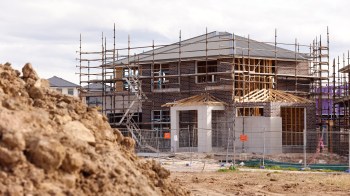A plan for building small homes in Haiti
TEXT OF INTERVIEW
BOB MOON: More than a million Haitians are still without homes since the massive earthquake that ripped apart that country last month. Many are living in tents, but the rainy season is coming in May and hurricanes may follow. Today the Miami-based company InnoVida offered up a solution: small homes made of fiber composite panels. That’s the hard stuff you’ve seen on airplanes around the interior walls and windows.
Herb Margolis is the CEO of U.S. operations.
HERB MARGOLIS: The 787 Dreamliner fuselage is made from composite materials. Bulkheads are made from composite materials. These things fly at 40,000 feet at 600, 700 miles an hour or what have you. The stresses are incredible.
The company’s pledged to build 1,000 homes and hopes to have a $15 million manufacturing facility in Haiti by year’s end.
Miami-based architect Andres Duany of the firm DPZ helped build cottages in New Orleans after Hurricane Katrina. And now he’s helping InnoVida design homes for Haiti. Mr. Duany, welcome to the program.
ANDRES DUANY: Thank you.
MOON: So I’m trying to envision exactly what this might look like. Can you describe these homes for us?
DUANY: Well, they’re rectangular, they’re 8-feet high and 8-feet wide, and they have a very large opening with a flap that opens up into a porch. So basically the house itself contains the bathroom, the kitchen, or the toilet, two bedrooms with eight beds, and they can paint it any color, they can add on to it. They can use it as a basic structure onto which to basically scab on additional rooms and materials. But I think it’s something they would recognize as the kinds of place they live in.
MOON: What are the challenges you all face getting these homes built in terms of terrain and manpower and that sort of thing?
DUANY: Well the manpower is available. Haitians are well-known to be hardworking. I think the challenge is there isn’t one terrain. There’s flat land, there’s rolling land, and there are hillsides. But the single greatest challenge is how to get rid of waste, because they don’t have much water. And so you can’t flush a toilet, you see. And so what we’ve developed or at least discovered is some very high-tech material, specifically a kind of plastic bag that is made in Sweden that you use, you seal, you know, you tie it up and in three weeks it’s compost, it’s usable compost. So what we have going here is a combination of very low tech, you know, no glass, no air conditioning, barely running water and very high tech.
MOON: Those images of the shanty towns down there have been really striking. Can these types of homes be sustainable in the long run?
DUANY: OK, well, that’s a question, that’s an interesting question. If one only provides the technical solution, which the U.N. has been doing for decades, and you study what the outcome is five years out, for example, in a book called, by Ian Davis, called “Resilient Cities.” And he says, if you don’t fit the culture, people will inhabit the buildings at first, because they do need the shelter, but then they’ll trash them and abandon them. Even within the category called the poor in Haiti, there at least four classes, and they behave differently. Some of them eat outside, some of them eat indoors, some of them eat in front of the house, some of them cook and eat in the back of the house, some of them have windows, and some of them don’t want windows because they believe the spirits enter through the windows. All these things because they’re contradictory have caused us to design not one but four different houses.
MOON: Now a 1,000 shelters is a wonderful gift, but it’s clearly not enough to serve the needs of so many Haitian homeless right now. What else needs to be done and how long is it going to take to provide enough shelter for all those people?
DUANY: Well, first of all, when you think of 1,000 shelters, and you think of it in terms of an American dwelling unit, that’s not that much. But remember that each of our dwellings houses eight, so 1,000 shelters is 8,000 people, OK? That’s a big hit. What I suggest is that everybody who has an idea, you know, there are so many clever ways to build that are fast and cheap, and so forth, I suggest that everybody have a go, because ours are dependent on donations. We can’t promise more than a 1,000. That’s the reality and many others have to step in.
MOON: Andres Duany is with the Miami architectural firm DPZ. Thank you very much, and good luck to you, sir.
DUANY: Thank you.
There’s a lot happening in the world. Through it all, Marketplace is here for you.
You rely on Marketplace to break down the world’s events and tell you how it affects you in a fact-based, approachable way. We rely on your financial support to keep making that possible.
Your donation today powers the independent journalism that you rely on. For just $5/month, you can help sustain Marketplace so we can keep reporting on the things that matter to you.


















